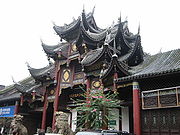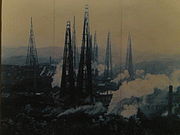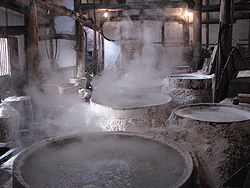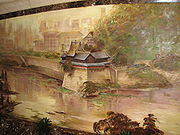
Zigong
Encyclopedia

Prefecture-level city
A prefectural level city , prefectural city or prefectural level municipality is an administrative division of the People's Republic of China, ranking below a province and above a county in China's administrative structure. Prefectural level cities form the second level of the administrative...
and the third largest city in Sichuan Province, in southwest China
Southwest China
Southwest China is a region of the People's Republic of China defined by governmental bureaus that includes the municipality of Chongqing, the provinces of Sichuan, Yunnan and Guizhou, and the Tibet Autonomous Region.-Provinces:-Municipalities:...
.
Geography
Zigong is located in the Sichuan BasinSichuan basin
The Sichuan Basin is a lowland region in southwestern China. Despite its historical name, it is not only synonymous to Sichuan province, comprising its central and eastern portions as well as part of Chongqing Municipality...
, and has an area extension of 4,372.6 km². Granted the recognition as one of the Historical and Cultural Cities of China by the State Council of the People's Republic of China
State Council of the People's Republic of China
The State Council of the People's Republic of China , which is largely synonymous with the Central People's Government after 1954, is the chief administrative authority of the People's Republic of China. It is chaired by the Premier and includes the heads of each governmental department and agency...
. Zigong has long been renowned as "Salt City" for its brine
Brine
Brine is water, saturated or nearly saturated with salt .Brine is used to preserve vegetables, fruit, fish, and meat, in a process known as brining . Brine is also commonly used to age Halloumi and Feta cheeses, or for pickling foodstuffs, as a means of preserving them...
extraction techniques and the attendant salt
Salt
In chemistry, salts are ionic compounds that result from the neutralization reaction of an acid and a base. They are composed of cations and anions so that the product is electrically neutral...
-related culture. In ancient China, Salt
Salt
In chemistry, salts are ionic compounds that result from the neutralization reaction of an acid and a base. They are composed of cations and anions so that the product is electrically neutral...
was regarded as the energy for body and valued higher even than Gold
Gold
Gold is a chemical element with the symbol Au and an atomic number of 79. Gold is a dense, soft, shiny, malleable and ductile metal. Pure gold has a bright yellow color and luster traditionally considered attractive, which it maintains without oxidizing in air or water. Chemically, gold is a...
. Therefore, salt trading was always the most profitable business and salt merchants were the wealthiest people. Hence, Zigong had always been one of the richest cities in China until the founding of People's Republic of China
People's Republic of China
China , officially the People's Republic of China , is the most populous country in the world, with over 1.3 billion citizens. Located in East Asia, the country covers approximately 9.6 million square kilometres...
with the introduction of new salt producing methods and advancing of technologies. It has had the Zigong Salt Museum
Zigong Salt Museum
Zigong Salt History Museum is a museum in the salt town of Zigong in Sichuan Province in western China. It was built in 1736 as the Xiqing Guildhall in the first year of emperor Qianlong, funded by the Shaanxi salt tradesmen, and used a meeting place for salt merchants from Shaanxi province the...
since 1736.
The Fuxi River, a tributary to the Yangtze River
Yangtze River
The Yangtze, Yangzi or Cháng Jiāng is the longest river in Asia, and the third-longest in the world. It flows for from the glaciers on the Tibetan Plateau in Qinghai eastward across southwest, central and eastern China before emptying into the East China Sea at Shanghai. It is also one of the...
, snakes through the city's core. The area is very humid and the visibility can be reduced dramatically in the area due to ground fog. The humidity and fog of Zigong can be attributed to that it sits on what was once a vast inland sea. Changes in the environment caused the water levels to subside leaving salt, brine, and natural gas.
During the summer months, the temperatures can reach as high as 40°C (104°F); during the winter months the temperatures hover around 15.5°C (60°F). The humidity hovers between 80% and 90% year round.
Using the coordinates link, one can find aerial photographic views, satellite imagery, night views, and road maps:
Coordinates: (29°20′6.60"N 104°46′25.39"E)
Zigong is situated south of the Sichuan basin hill country. To the east of Zigong is Luzhou
Luzhou
-History:The history of Luzhou dates back to Xia and Shang Dynasties. Luzhou became a prefecture level city in 1983.-History of Luzhou:...
and to the west of Zigong is Leshan
Leshan
-Administrative divisions:-Transport:There is a passenger rail line that serves the Mianyang–Chengdu–Leshan inter-city area.The Chengdu-Leshan Highway with a total length of 160 kilometers, was finished on January 14th, 2000...
. To Zigong's south is Yibin
Yibin
-Administrative divisions:-Economy:The city's industry focuses on electronics, food products, and power generation. It also produces paper, silk, and leather products...
and to the north-east is the city of Neijiang
Neijiang
Neijiang is a prefecture-level city in the Southeast of Sichuan Province, in southwest of China, with a population of about 4,200,000. It is located on the Tuo River and is a transportation and food-processing center...
.
Demographics
According to the 2010 CensusSixth National Population Census of the People's Republic of China
The Sixth National Population Census of the People's Republic of China, also referred to as the 2010 Chinese Census, was conducted by the National Bureau of Statistics of the People's Republic of China with a zero hour of November 1, 2010....
, the prefecture-level city of Zigong has a population of 2,678,898, 354,865 inhabitants less than in 2000 (the average annual population growth for the period 2000-2010 was of -1.24%).
Administrative divisions

Today there are four municipal districts and two counties of the Zigong Prefecture. The information here presented uses the metric system and data from 2010 Census.
| Map | |||||||
|---|---|---|---|---|---|---|---|
| # | English Name | Simplified | Traditional | Pinyin | Area | Population | Density |
| 1 | Ziliujing District Ziliujing District Ziliujing District is a district of Zigong city, Sichuan Province, China.*The district covers 153 square kilometres with a population of 330,000 in 2005.-External links:*... |
自流井区 | 自流井區 | Zìliújǐng Qū | 153 | 346,401 | 2,264 |
| 2 | Da'an District Da'an District, Zigong Da'an District is a district of Zigong city, Sichuan Province, China.*The district covers 400 square kilometres with a population of 456,000 in 2007.-External links:*... |
大安区 | 大安區 | Dà'ān Qū | 400 | 382,245 | 956 |
| 3 | Gongjing District Gongjing District Gongjing District is a district of Sichuan Province, China. It is under the administration of Zigong city.... |
贡井区 | 貢井區 | Gòngjǐng Qū | 418 | 260,607 | 623 |
| 4 | Yantan District Yantan District Yantan District is a district of Sichuan Province, China. It is under the administration of Zigong city.... |
沿滩区 | 沿灘區 | Yántān Qū | 469 | 272,809 | 582 |
| 5 | Rong County | 荣县 | 榮縣 | Róng Xiàn | 1,598 | 590,640 | 370 |
| 6 | Fushun County Fushun County, Sichuan Fushun County is a county of Sichuan Province, China. It is under the administration of Zigong city.-History:Fushun has a history over 1400 years. The county was built in 567 BC during the Southern and Northern Dynasties of China.-External links:*... |
富顺县 | 富順縣 | Fùshùn Xiàn | 1,333 | 826,196 | 620 |
Both previous cities - Gongjing and Ziliujing made up what had become one of the busiest saltworks (or saltyards as they are called locally) in China - the Furong Saltyard. The main products were a uniquely rich salt called "hua" salt - which dominated salt from the other Sichuan producers and the "ba" salt which became popular in other provinces in China.
History
The area of Zigong has a long history in ancient China - with the invention and development of "Percussion Drilling rigDrilling rig
A drilling rig is a machine which creates holes or shafts in the ground. Drilling rigs can be massive structures housing equipment used to drill water wells, oil wells, or natural gas extraction wells, or they can be small enough to be moved manually by one person...
" being one of the city's accomplishments. There are essentially two cities - that of the old and the new. The city was reached by rail in the 1950s. Several four lane highways reach the city from other cities in the Sichuan
Sichuan
' , known formerly in the West by its postal map spellings of Szechwan or Szechuan is a province in Southwest China with its capital in Chengdu...
province. The new city of Zigong has been modernizing since the late 1970s - but more rapidly since the early 1990s. The old "Salt
Salt
In chemistry, salts are ionic compounds that result from the neutralization reaction of an acid and a base. They are composed of cations and anions so that the product is electrically neutral...
" city is based on industry and farmland and a new "Tourism
Tourism
Tourism is travel for recreational, leisure or business purposes. The World Tourism Organization defines tourists as people "traveling to and staying in places outside their usual environment for not more than one consecutive year for leisure, business and other purposes".Tourism has become a...
" city which caters primarily to Chinese tourists (as Zigong is better known within mainland China). Zigong is host to the Sichuan University of Science and Engineering as well as a new High Technology Zone.
Zigong Dinosaur Museum

Dashanpu Formation
The Dashanpu Formation is a Mid to Late Jurassic rock formation in China, most notable for the wealth of dinosaurs that have been excavated from the area...
, 7 km north-east from downtown Zigong, including a dinosaur named after the township, Dashanpusaurus
Dashanpusaurus
Dashanpusaurus is an extinct genus of sauropod dinosaur that lived during the middle of the Jurassic period. The dinosaur was described in 2005 by a group of Chinese paleontologists. The dinosaur's binomial name, Dashanpusaurus dongi, was named after a prolific dinosaur expert of the Dashanpu...
. Because of the unique and intact bone remains, Zigong has ever since been attracting paleontologists and dinosaur
Dinosaur
Dinosaurs are a diverse group of animals of the clade and superorder Dinosauria. They were the dominant terrestrial vertebrates for over 160 million years, from the late Triassic period until the end of the Cretaceous , when the Cretaceous–Paleogene extinction event led to the extinction of...
enthusiasts from around the world. In 1987, the Zigong Dinosaur Museum
Zigong Dinosaur Museum
Located near the Prefecture-level city of Zigong, China, in the smaller township of Dashanpu, is the Zigong Dinosaur Museum. The museum sits on top of a large concentration of dinosaur fossils — both in terms of quantity but also of diversity. The museum claims the largest number of dinosaur...
was established, becoming the first specialized dinosaur museum open in Asia. Mounted specimens include Omeisaurus
Omeisaurus
Omeisaurus is a genus of sauropod dinosaur from the Middle Jurassic Period of what is now China. Its name comes from Mount Emei, where it was discovered in the lower Shaximiao Formation of Sichuan Province.Like other sauropods, Omeisaurus was herbivorous and large...
, Gigantspinosaurus
Gigantspinosaurus
Gigantspinosaurus is a genus of herbivorous ornithischian dinosaur from the Late Jurassic. It was a stegosaur found in Sichuan, China....
, Yangchuanosaurus hepingensis
Sinraptor
Sinraptor is a genus of theropod dinosaur from the Late Jurassic. The name Sinraptor comes from the Latin prefix "Sino", meaning Chinese, and "Raptor" meaning thief. The specific name dongi honours Dong Zhiming...
, Huayangosaurus
Huayangosaurus
Huayangosaurus is a genus of stegosaurian dinosaur from the Middle Jurassic of China. The name derives from "Huayang", an alternate name for Sichuan , and "saurus", meaning "lizard"...
and Xiaosaurus
Xiaosaurus
Xiaosaurus , is a genus of small herbivorous dinosaur from the middle Jurassic, approximately 169 to 163 mya. Xiaosaurus lived in what is now the Sichuan Basin of China....
.
Economy


Salt well
A salt well is used to mine salt from subterranean caverns or deposits by the use of water as a solution to dissolve the salt or halite deposits so that they can be extracted by pipe to an evaporation process that results in a brine or dry product for sale or use...
s of Sichuan". The best salt wells in Sichuan are in Zigong.
The people of Zigong have been drilling in the area for Salt
Salt
In chemistry, salts are ionic compounds that result from the neutralization reaction of an acid and a base. They are composed of cations and anions so that the product is electrically neutral...
since before the Han Dynasty (76-88 A.D.) to extract salt from brine. Some historian estimates are that China has been active in producing salt since about 6000 BC. The brine aquifers in the area have salinity of at least 50 grams per liter. The classical method of drilling and production was the following: a drilling rig
Drilling rig
A drilling rig is a machine which creates holes or shafts in the ground. Drilling rigs can be massive structures housing equipment used to drill water wells, oil wells, or natural gas extraction wells, or they can be small enough to be moved manually by one person...
is erected and a borehole is drilled using a drilling bit and rope. Brine is extracted by dropping a long tube down the borehole. A membrane valve then captures the brine for retrieval on the surface. Once the brine is retrieved it's then piped to flat pans for boiling. In the boiling process some water and crushed yellow soybean is added. The soybean absorbs the impurities in the salt. Once boiled, a yellow layer is formed - this is scraped off leaving absolutely pure salt. The salt is a medium grain salt with different size flakes which have a very strong and unique salt taste. This salt has no additives so it does clump. Locals use grains of rice in the salt to keep the salt from clumping.
Early methods of brine salt production involved digging large pits in the earth (other parts of China used the evaporation method). Later methods involved very innovative drilling and retrieval methods. An unexpected byproduct of the drilling and resulting wells was natural gas. Since natural gas didn't have the uses it does today, it was channeled into pipes and primarily used onsite to boil the brine and extract the salt. The salt Zigong produced was very rich in taste and was served to the Emperor of China as a tribute. The people of Zigong believe its taste to be superior to the popular french sea salts such as Fleur de sel
Fleur de sel
Fleur de sel is a hand-harvested sea salt collected by workers who scrape only the top layer of salt before it sinks to the bottom of large salt pans...
.
Salt production via boreholes was once prevalent in the entire Sichuan area - but for several factors (war, rebellion, taxes, wells drying up) Zigong became the center of production. Salt wells in Zigong were deeper and had better brine salinity - making for better yields in the salt extraction process. The method in which boreholes were drilled is significant. In 1835, the world's (at that time) deepest well was drilled reaching 3,300 feet (compared with a much publicised well in Pennsylvania at 69.5 feet). Wealthy families of the Sichuan city of Jingyan invented deep percussion drilling techniques used in Zigong - 400 years before the Europeans. The miners of Zigong refined the techniques of deep borehole drilling. Later, Europeans copied and further refined the percussion drilling methods - so its effects can be seen in the modern Drilling rig
Drilling rig
A drilling rig is a machine which creates holes or shafts in the ground. Drilling rigs can be massive structures housing equipment used to drill water wells, oil wells, or natural gas extraction wells, or they can be small enough to be moved manually by one person...
used for oil and water.
Salt became an engine of commerce and wealth for Zigong. There were cheaper methods for salt production, as to start a borehole well cost 3,000 pieces of silver, but transportation cost into the Sichuan valley negated the cheaper production methods (as they usually involved sea water). Zigong is located in the central Chinese Sichuan
Sichuan
' , known formerly in the West by its postal map spellings of Szechwan or Szechuan is a province in Southwest China with its capital in Chengdu...
province, which was a large basin, surrounded by mountains on three sides and therefore somewhat isolated. Before refrigeration was available salt was a key chemical used in preserving vegetables, meat, and fish. Because of the factors mentioned above (war, wells drying up, and a rebellion) Zigong became a significant supplier of salt to the Sichuan province up until the 1930s. In 1892, miners discovered a vein of rocksalt that feeds Zigongs aquifers. In 1946, a well was drilled with a rotary drillbit. Ancient percussion drilling methods became obsolete and most of the drilling rigs were torn down due to decay. Today, only one traditional salt well still exists, the Shenhai Well, as a tribute to the workers and industry. The Shenhai Well (Bore depth: 1,001.4 meters/4,400 feet) still operates using the older manual methods of pumping and boiling. The salt is used for pickling or canning - and makes an important ingredient to Sichuan style pickles (which are a local favorite). In the modern day, Zigong is a primary source for Natural Gas, Coal, and Inorganic Chemical Production in addition to salt.
Lantern Festival
Zigong is the originator of the Chinese Lantern FestivalLantern Festival
The Lantern Festival ; is a festival celebrated on the fifteenth day of the first month in the lunisolar year in the Chinese calendar, the last day...
- which has been copied in Beijing, Hong Kong, and Shanghai. As one of the Historical and Cultural Cities of China, Zigong is called "Lantern Town in the South Kingdom". In recent years, although the annual lantern show forces the local residents endure unpredictable and extended blackouts during China's Spring Festival, the lantern festival is a boon for tourism in the remote but tranquil city and generates large revenues for the local government. The pattern of Lantern Show, a paradigm of China's festival economy, has been copied throughout China, which dilutes the uniqueness of Zigong's original version. As a measure to promote the city, the lantern show has already been brought to many cities in mainland China and even southeast Asia throughout of the years.
Since China is on a Lunar calendar - known in the west as the Chinese calendar
Chinese calendar
The Chinese calendar is a lunisolar calendar, incorporating elements of a lunar calendar with those of a solar calendar. It is not exclusive to China, but followed by many other Asian cultures as well...
, Spring Festival - which is also known as Chinese New Year
Chinese New Year
Chinese New Year – often called Chinese Lunar New Year although it actually is lunisolar – is the most important of the traditional Chinese holidays. It is an all East and South-East-Asia celebration...
will vary each year on a Gregorian calendar
Gregorian calendar
The Gregorian calendar, also known as the Western calendar, or Christian calendar, is the internationally accepted civil calendar. It was introduced by Pope Gregory XIII, after whom the calendar was named, by a decree signed on 24 February 1582, a papal bull known by its opening words Inter...
- but is roughly between January 16 and February 19 each year - depending on which of the Twelve earthly branches
Earthly Branches
The Earthly Branches provide one Chinese system for reckoning time.This system was built from observations of the orbit of Jupiter. Chinese astronomers divided the celestial circle into 12 sections to follow the orbit of Suìxīng . Astronomers rounded the orbit of Suixing to 12 years...
it is currently.
The Lantern Festival has been going on since the Tang dynasty and gets more elaborate each year and is certainly a sight to behold.
Zigong Teahouse

Zigong Salt Museum
Zigong Salt History Museum is a museum in the salt town of Zigong in Sichuan Province in western China. It was built in 1736 as the Xiqing Guildhall in the first year of emperor Qianlong, funded by the Shaanxi salt tradesmen, and used a meeting place for salt merchants from Shaanxi province the...
and is used to generate funds for the museum. However, the original purpose of the Teahouse was the assembly hall for shipping Merchants and called Wangye Miao Temple. For its origin please refer to "Merchants Assembly Halls" below.
The Ancient Streets
Along the Fuxi river are several stone paved roads that are called the "ancient streets". This section of Zigong has traditional houses and shops, typical of life in the days that Zigong was a bustling Salt trade center. Several salt well heads are capped and marked along the streets that wind along the river. At the end of the street is a hand rowed ferry boat that takes a visitor to the opposite shore where stone steps led up into the city.Tourist Sites
San Duo Zhai (Chinese:三多寨)is a fortress complex built in 1859 by three rich families on the top of steep mountain, to protect themselves from the banditis and warlord during Chaos period. The name of the fortress means long happiness, long live, and more boy birth (多福、多寿、多男子). Located along the Zigong to Neijiang expressway, about 20 km drive from the city, hiring a roundtrip taxi would cost about 50RMB.Rongxian Buddha (Chinese:荣县大佛) is the second largest sitting stone Buddha in the world. Located in Rongxian County, about 40 km drive from the city, hiring a roundtrip taxi would cost about 100RMB.
Fushun Confucius Temple 富顺文庙, built in 1044, is the only Confucius temple in the world with a naked Confucius image on the top of the roof.
Xianshi - the ancient Town 仙市古镇, is a small town with over 1,400 years history of salt shipping, however, still kept most of its houses and streets in the ancient styles, 10 minutes from the city, along the Fuxi river.
Night view of Fuxi river - you can step on to the touring boat for only 20 rmb with snacks and tea serving, and enjoying the amazing view of ancient "salt river" and imagining the busy ports by the restored sites.
Merchants Assembly Halls
Xiqing assembly hall 西秦会馆 is the most famous and beautiful Meachants Hall in China, located in the old city downtown. Built in 1800, for the purpose of assemble Salt Merchants from Shanxi province.Wangye Miao Temple 王爷庙, is the assembly hall for shipping Merchants, located in the old city downtown along the Fuxi river, with a estimated history of over 300 hundred years. The purpose is to serve both assembly and protection from the river god. the temple is delicatedly build on a cliff of the Fuxi river with designs being able to detect groundwork condition. The two original unique structure of this temple is road crossing inside the temple and the rare genuine Sichuan Oprea Platform.
Henghou Ci Temple 桓侯祠 is the assembly hall for butchers built in 1875. The construction fund come from the butchers' rule "whenever a pig is killed, two hundred cents should be donated".
Local Food and Dishes
Zigong Food is one of a kind even in Sichuan, due to its rich culture and history. Some dishes found in Zigong are common to the SichuanSichuan
' , known formerly in the West by its postal map spellings of Szechwan or Szechuan is a province in Southwest China with its capital in Chengdu...
area (see Szechuan cuisine
Szechuan cuisine
Szechuan cuisine, Sichuan cuisine, or Szechwan cuisine is a style of Chinese cuisine originating in the Sichuan Province of southwestern China famed for bold flavors, particularly the pungency and spiciness resulting from liberal use of garlic and chili peppers, as well as the unique flavour of...
with local variations, and some are unique local recipes.
- Various types of DumplingDumplingDumplings are cooked balls of dough. They are based on flour, potatoes or bread, and may include meat, fish, vegetables, or sweets. They may be cooked by boiling, steaming, simmering, frying, or baking. They may have a filling, or there may be other ingredients mixed into the dough. Dumplings may...
or WontonWontonNot to be confused with WantonA wonton is a type of dumpling commonly found in a number of Chinese cuisines.-Filling:...
(served with hot oil and pepper paste) called chāo shǒu - Sichuan Hot potHot potHot pot , less commonly Chinese fondue or steamboat, refers to several East Asian varieties of stew, consisting of a simmering metal pot of stock at the center of the dining table. While the hot pot is kept simmering, ingredients are placed into the pot and are cooked at the table...
, called Chuan Chuan Xiang - Twice Cooked PorkTwice Cooked PorkTwice cooked pork , along with Mapo Dofu , hot pot and Kung Pao chicken , is a well-known Sichuan-style Chinese dish....
- Pepper Beef
- Mapo doufuMapo doufuMapo doufu, or mapo tofu, is a popular Chinese dish from the Sichuan province. It is a combination of tofu set in a spicy chili- and bean-based sauce, typically a thin, oily, and bright red suspension, and often cooked with minced meat, usually pork or beef...
- Diced Rabbit in Hot Pepper Oil
- Frog
- Fried Eel with Hot Peppers
- Turtle Soup
- Duck in a Hot Pepper Oil
- Tea Infused Duck
- Sichuan DanDan Mian - spicyChinese noodlesChinese noodlesNoodles are an essential ingredient and staple in Chinese cuisine. There is a great variety of Chinese noodles, which vary according to their region of production, ingredients, shape or width, and manner of preparation...
- Various Types of TeaTeaTea is an aromatic beverage prepared by adding cured leaves of the Camellia sinensis plant to hot water. The term also refers to the plant itself. After water, tea is the most widely consumed beverage in the world...
- Babe Toufu (best in Fushun county and counryside)
Unique dishes include:
- Fried rice-field frogFrogFrogs are amphibians in the order Anura , formerly referred to as Salientia . Most frogs are characterized by a short body, webbed digits , protruding eyes and the absence of a tail...
with fresh pepper (very spicy pepper) (This dish is illegal) - Rice-field frogFrogFrogs are amphibians in the order Anura , formerly referred to as Salientia . Most frogs are characterized by a short body, webbed digits , protruding eyes and the absence of a tail...
chicken soup (only a few families know how to make this soup)
Try the night food market along the roads (Tongxing Lu), and remember best food are cooked at local's home.
Famous people
Since the first century, thousands of pre-eminent people have been calling Zigong home. Among them the most famous individuals are Wu YuzhangWu Yuzhang
Wu Yuzhang was a Chinese politician and educationist, President of Renmin University of China from 1950 to 1966.-Biography:...
, Gao Ming
Gao Ming
Gao Ming is a retired Chinese football player.-Qingdao:His career at Qingdao was a big success. He started representing Qingdao Etsong in senior level matches in 2000. Alongside with Qu Bo, they were considered to be one of the best attacking partners in China.-Shandong Luneng:Shandong Luneng...
, Liu Guangdi, Jiang Zhujun, Zou Nian, Wei Minglun, Tan Wei Wei and Kelly Xie.
Liu Zhengyou has been deeply involved in efforts to protect the rights of local farmers, who were forcibly evicted from their land (on which their housing and livelihood depend) without being properly consulted or fairly compensated.
Indeed, in 1993, Zigong officials began to seize more than 2,500 acres of farm land, on which 30,000 farmers had lived for generations. The farmers were offered small living stipends and what they considered inadequate compensation, so they refuse to relocate and organised sit-ins. Police came to the villages many times to “clean out” villagers. Between 1995 and 2005, Mr. Liu Zhengyou, who had been designated by the farmers as their leader, petitioned the government for investigation and review. On April 20, 2005, villagers tried to hand in a petition to the Mayor of Zigong, but were stopped by the police. During the altercation with the police, several villagers were badly injured, including Mr. Liu. Mr. Liu and several others were then briefly detained for “disorderly conduct” and “obstruction of traffic”.
The 2010 Peace Nobel Prize winner Liu Xiaobo
Liu Xiaobo
Liu Xiaobo is a Chinese literary critic, writer, professor, and human rights activist who called for political reforms and the end of communist single-party rule in China...
wrote that when Liu Zhengyou was kidnapped on April 16th 2006 at Beijing Airport to fly to Geneva to attend the UN human rights conference, it was a trial for the new UN Human Rights Council to see if it's capable of responding to this evident human rights abuse and tell the world whether the reformed UN human rights organization can live up to its expectation or not.
Books
- "The Merchants of Zigong - Industrial Entrepreneurship In Early Modern China by Madeleine Zelin" Columbia Press (ISBN 0-231-13596-3)
- "The Great Well of China" by Hans Ulrich Vogel, Scientific American, June 1993
- "Salt: A World History" by Kurlansky, Mark. Penguin, 2003 (ISBN 0-8027-1373-4)hc (ISBN 0-14-200161-9)pbk
- "On Their Own Terms: Science in China, 1550-1900", Benjamin A. Elman (ISBN 0-674-01685-8)

